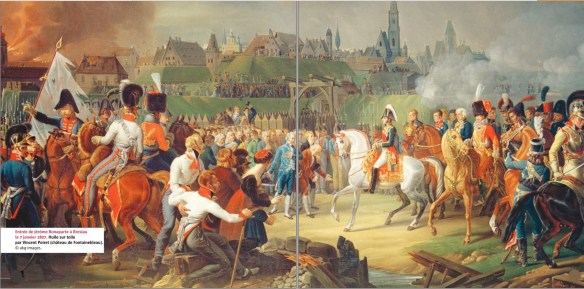
In an attempt to secure accurate information of Russian intentions, on November 5 1806 Napoleon ordered Davout “to scour the country in advance” and make a reconnaissance with the 2,500 dragoons of General Beaumont’s division as far as Posen. At the same time, on the southern flank, Jerome Bonaparte was instructed to seize Glogau in Silesia. While these moves were being executed, new and crucial intelligence reached Imperial Headquarters on the 9th.
A force of at least 56,000 Russians had definitely moved westward from Grodno in late October, which made it quite possible that they could have reached the easternmost frontiers of Prussia by the end of that month, and might well arrive near the vital center of Thorn on the Vistula by mid-November. Two days later, Davout reported that there was no sign of the enemy near Posen, where he was in the process of setting up field bakeries. On the basis of these pieces of information Napoleon finally made up his mind. Although the exact position of the Russians and the real intentions of Austria were not yet clear, it was certainly in his interest to secure the most advantageous winter quarters from which to launch a decisive offensive in the spring of 1807. If the Russian commander, General Bennigsen, was to be forestalled on the Vistula and prevented from joining up with Lestocq’s Prussian corps in the vicinity of Warsaw, it behoved Napoleon to advance at once and occupy both Thorn and the Polish capital with the minimum of delay. Once he had gained the west bank of the Vistula, he could decide on the advisability of any further advance in the light of the information that would by then have come to hand; if necessary, he could turn to deal with Austria.
Orders were accordingly issued. The initial advance was to be made on a broad front behind a screen of cavalry with the intention of acquiring the earliest possible tidings of Russian dispositions. Eighty thousand men, comprising the corps of Davout, Lannes, Augereau and Jerome, under the temporary command of Murat, were designated for this task. To the north, the Vth and VIIth Corps would move from Stettin and Berlin respectively towards Thorn, while in the center Davout’s IIIrd Corps was to push on beyond Posen and make for Warsaw. To the south, Jerome’s command (the IXth Corps) was to advance from Glogau toward Kalisch in such a way as to secure the southern flank against any possibility of Austrian intervention (however remote this likelihood now appeared); while on his extreme right, General Vandamme’s division was to move on Breslau to seize the Silesian fortresses as occasion offered.
Napoleon orders Jérôme to press down the River Oder to Breslau, to take this important fort. Poland is peppered with fortified towns, and Napoleon knows that as his army advances, every one of these hostile islands of stone must be taken, otherwise his lines of supply and communication will remain vulnerable.
The extreme northern flank was entrusted to Mortier’s VIIIth Corps on the 11th, Louis Bonaparte being ordered back to guard Holland. Napoleon himself would, for the present, remain at Berlin organizing the rear areas and ensuring that the remaining corps of the Grande Armée, as they returned from pursuing Blücher, were sent forward along the correct roads in the second wave—namely, Bernadotte and Ney toward Thorn, and Soult (with his own command and the four cavalry divisions constituting Bessières’ Second Cavalry Reserve) in the direction of Warsaw.
Napoleon’s decision to invade Poland was not wholly dictated by military requirements; there was also a strong political motive. During the past 35 years this unfortunate country had no less than three times been partitioned by its powerful and voracious neighbors, Russia, Prussia and Austria. The Emperor was well aware that he was now in a position to play the role of “deliverer,” and by reconstituting the ancient kingdom might hope to gain a cooperative ally in eastern Europe besides perhaps 50,000 troops to swell the Grande Armée. Once again, his motives were wholly opportunist; in his heart of hearts Napoleon evinced little true sympathy with Polish national aspirations. “Poland! So much the worse for them,” he once exclaimed. “They have allowed themselves to be partitioned. They are no longer a nation—they have no public spirit. The nobles are too much; the people too little. It is a dead body to which life must be restored before anything can be made of it. I will make officers and soldiers of them first; afterward I shall see. I shall take Prussia’s portion; I shall have Posen and Warsaw, but I will not touch Cracow, Gallicia or Vilna.” Indeed, Poland required careful handling; too brusque an approach might sting Austria into immediate hostilities, and Napoleon was equally eager not to overoffend the Tsar’s known susceptibilities and thus compromise any future chance of a negotiated settlement. In consequence he was careful not to make any direct promise of political freedom, nor did he call on the Poles to revolt against their present masters. Once Warsaw was in his hands, he contented himself with forming the six departments already wrested from Prussia into a semiautonomous political unit, setting over it a council of seven Polish noblemen. For the rest, Napoleon was very cautious. “I should like to make Poland independent, but that is a difficult matter,” he once confided to Bourienne. “Austria, Russia and Prussia have all had a slice of the cake; when the match is once kindled, who knows where the conflagration may stop…. We must refer this matter to the sovereign of all things—time.”
Battles continue in the Grand Army’s rear, with the campaign against enemy fortresses in Silesia and Pomerania. In the former province, Jérôme’s IX Corps – having marched south-east from Breslau to subdue Prussian garrisons at Brieg and Schweidnitz – is investing Kosel and Neisse.